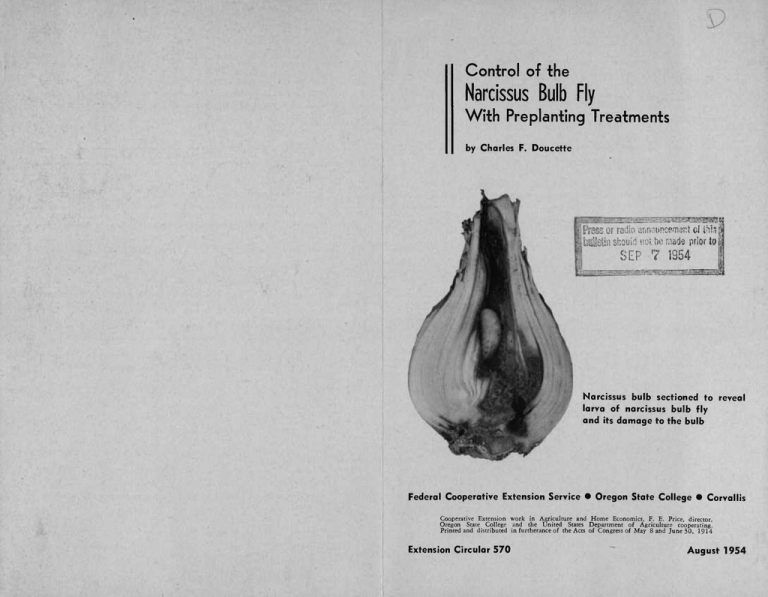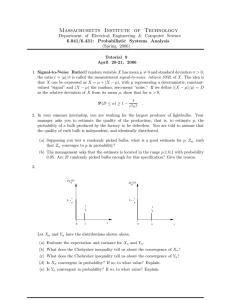9 Narcissus Bulb Fly Control of the With Preplanting Treatments
advertisement

9 Control of the Narcissus Bulb Fly With Preplanting Treatments by Charles F. Doucette Press or radio announceownt of this I blMn shouid not be Made prior to SEP 7 1954 ■^=^. Narcissus bulb sectioned to reveal larva of narcissus bulb fly and its damage to the bulb Federal Cooperative Extension Service • Oregon State College • Corvallis Cooperative Extension wotk in Agriculture and Home Economics, F. E. Price, director. Oregon State College and the United States Department of Agriculture cooperating. Printed and distributed in furtherance of the Acts of Congress of May Sand June 30, 1914 Extension Circular 570 August 1954 Control Control of the Narcissus Bulb Fly with Preplanting Treatments Charles F. Doucette1 Control methods have been developed which completely protect the bulbs from attack. Before planting, soak the dormant bulbs in a dilute emulsion of heptachlor. The amounts of emulsifiable concentrate needed are as follows: Amount1 for 100 gallons 25 gallons The narcissus bulb fly is the most harmful insect affecting narcissus bulbs in the Pacific Northwest. It is a serious problem for commercial bulb growers, and is particularly severe in garden plantings. The grubs' feeding completely destroys small bulbs and seriously damages the larger ones. Some gardeners have reported practically complete loss of narcissus bulbs in their plantings. Losses as high as 75 per cent have been reported in commercial plantings. HEPTACHLOR (25 per cent, 2 pounds per gallon) 2 quarts 1 pint 5 gallons 3 fluid ounces It is advisable that the heptachlor be combined with one of the fungicides used for basal rot treatment, either phenyl mercuric acetate or 2 per cent Ceresan. The amounts required of either are: Amount for 100 gallons Habits and Life History The adult flies appear in May and June and are most active on warm sunny days. They feed on the nectar and pollen of various flowers. This is one reason why narcissus bulbs in gardens are so seriously affected. The flies go to the gardens to feed on the flowers, and then lay eggs on the narcissus plants. The eggs are laid on the leaves at the ground level or as much below the soil surface as the female can place them. The newly hatched larva works its way down the side of the bulb and usually enters through a root at its junction with the base of the bulb. The larva feeds first in the basal plate and then forms a cavity within the bulb filled with moist, granular, brown, decayed bulb tissue. The larva becomes mature in the fall, but remains in the bulb through the winter. In early spring it leaves the bulb, moves upward to the soil surface, where it forms a puparium in which it changes to the adult fly. When ready to emerge the fly pushes off the cap of the puparium, wriggles out, and climbs a nearby stem or piece of debris, where it spreads out and dries its wings. 1 Entomologist, Entomology Research Branch, Ornamentals Insect Research Laboratory, Agricultural Research Service, USDA, stationed at Sumner, Washington. This circular was published concurrently as the State College of Washington's Extension Circular 247. Phenyl mercuric acetate 2 per cent Ceresan 25 gallons 5 gallons 1 ounce 1/5 ounce 2 /2 pounds 8 ounces 31/2 ounces 10 pounds 1 If neither of these fungicides is available, formalin may be used at the rate of 2 quarts per 100 gallons of emulsion (6 tablespoonfuls for 5 gallons). This is to prevent the spread of fungus spores. While the period of soaking need not exceed 10 minutes, immersion periods up to an hour may be used safely and increase effectiveness. The strength of the insecticides is not affected by the number of lots treated, but when the quantity of emulsion drops about one-third from the original, it is preferable to prepare a new batch rather than replenish the old. CAUTION—Insecticides are poisons. Observe proper precautions in handling and using them. The concentrates may be absorbed through the skin, so wear rubber gloves when measuring and pouring them. The insecticide will accumulate on the hands when treated bulbs are handled during planting. After handling treated bulbs, wash your hands thoroughly with soap and water.






